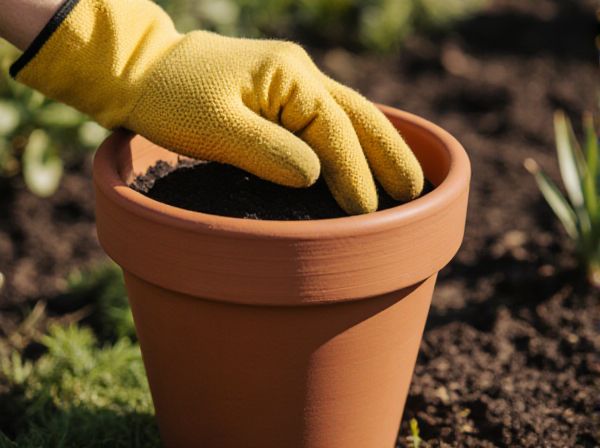
Terracotta pot vs glazed pot Illustration
Terracotta pots provide natural breathability and moisture regulation, ideal for plants that prefer well-aerated soil, while glazed pots offer a waterproof barrier that retains moisture longer, reducing the frequency of watering. The porous nature of terracotta also allows excess salts to escape, preventing root damage, whereas glazed pots prevent evaporation but may lead to waterlogged soil if not properly drained. Both options vary in weight and aesthetic appeal, with terracotta pots lending a rustic, earthy look and glazed pots offering vibrant, decorative finishes.
Table of Comparison
| Feature | Terracotta Pot | Glazed Pot |
|---|---|---|
| Material | Porous clay | Clay with a glazed, non-porous surface |
| Water Retention | Good drainage, dries out faster | Retains moisture longer |
| Breathability | High, allows air to reach roots | Low, less air exchange |
| Weight | Light to medium | Heavier due to glaze |
| Durability | Fragile, prone to cracking | More durable, resistant to cracking |
| Appearance | Matte, natural earthy look | Glossy, vibrant colors |
| Best Use | Succulents, herbs, plants needing dry soil | Tropical plants, moisture-loving plants |
| Cost | Generally affordable | Usually pricier |
Introduction to Terracotta and Glazed Pots
Terracotta pots are made from natural clay, offering porous qualities that promote air and moisture exchange, beneficial for plant root health. Glazed pots feature a glass-like coating that makes them non-porous, retaining moisture longer and providing a decorative finish. Choosing between terracotta and glazed pots depends on plant water needs and aesthetic preferences.
Material Composition and Manufacturing Process
Terracotta pots are made from natural clay fired at lower temperatures, resulting in a porous and breathable material that allows air and moisture to pass through, benefiting plant roots. Glazed pots consist of clay coated with a vitreous glaze and fired at higher temperatures, creating a non-porous, water-resistant surface that provides durability and vibrant colors. The manufacturing process for terracotta emphasizes traditional handcrafting and low-temperature kilns, while glazed pots involve an additional glazing step and high-temperature firing to achieve their distinctive finish.
Appearance and Aesthetic Appeal
Terracotta pots offer a natural, earthy appearance with a warm, reddish-brown hue that enhances the rustic charm of plants and outdoor spaces. Glazed pots provide a glossy, vibrant finish available in various colors and patterns, adding a polished and decorative touch to interiors and gardens. The porous texture of terracotta contrasts with the smooth, reflective surface of glazed pots, influencing both visual appeal and plant health.
Porosity and Water Retention
Terracotta pots are highly porous, allowing air and moisture to pass through the walls, which helps prevent overwatering but requires more frequent watering due to higher evaporation rates. Glazed pots have a non-porous surface that retains moisture longer, making them ideal for plants needing consistent hydration and reducing water loss. The choice between terracotta and glazed pots depends on a plant's water needs and the grower's irrigation frequency.
Durability and Weather Resistance
Terracotta pots, made from porous clay, offer moderate durability but tend to absorb moisture, which can cause cracking in freezing weather. Glazed pots feature a protective, non-porous coating that enhances weather resistance and prevents water absorption, making them more durable in harsh climates. Both types withstand general outdoor conditions, but glazed pots provide superior long-term durability against frost and heavy rain.
Weight and Portability
Terracotta pots are typically lighter and more porous, making them easier to move and ideal for plants that need good air circulation and drainage. Glazed pots, while heavier due to the ceramic coating, offer enhanced durability and moisture retention but can be less portable. The choice between terracotta and glazed pots depends on the balance between weight, ease of handling, and specific plant care requirements.
Suitability for Different Plant Types
Terracotta pots offer excellent breathability, making them ideal for plants that prefer well-drained soil, such as succulents and cacti, because they allow moisture to evaporate more quickly. Glazed pots retain moisture longer, benefiting tropical plants and moisture-loving species like ferns and peace lilies by maintaining consistent soil hydration. Choosing between terracotta and glazed pots depends largely on a plant's water requirements and root aeration needs.
Cost Comparison and Budget Considerations
Terracotta pots generally cost less than glazed pots, making them a budget-friendly choice for gardeners looking to maximize planting containers without high expenses. Glazed pots, due to their decorative finish and durability, tend to have higher prices but may offer better longevity and waterproofing. When considering cost, factor in potential long-term savings with glazed pots due to their resilience versus the more frequent replacement needs of terracotta containers.
Maintenance and Cleaning Requirements
Terracotta pots require regular maintenance to prevent cracking and salt buildup, as they are porous and absorb water, leading to potential mineral deposits on the surface. Glazed pots, being non-porous, are easier to clean and resist stains, requiring only occasional wiping to maintain their appearance. Both types benefit from gentle cleaning with mild soap and water, but terracotta demands more frequent care to ensure longevity.
Eco-Friendliness and Sustainability
Terracotta pots are highly eco-friendly due to their natural, porous clay composition that allows for better air and water circulation, promoting healthier plant growth without synthetic coatings. In contrast, glazed pots often involve chemical treatments and non-biodegradable glazes that can impact soil quality and reduce overall sustainability. Choosing terracotta supports renewable resources and biodegradable materials, aligning with sustainable gardening practices and reducing environmental impact.
Terracotta pot vs glazed pot Infographic

 gardendif.com
gardendif.com